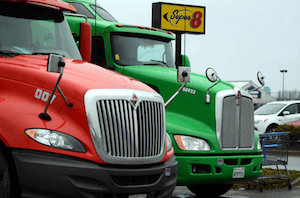3 Fleet Tracking Tips to Get the Most Out of Your Fleet Tracking Solution


Fleet tracking is a business process involving tracking vehicles using a GPS system that gathers data to improve your fleet’s overall performance. Businesses that use fleet tracking enhance the performance of their fleet, reduce costs, and improve fleet efficiency by minimizing idling, unauthorized usage, unsafe driving practices, and speeding. Fleet tracking also leads to optimized routes, which decreases the cost of fuel and improves schedules. Other benefits of fleet tracking include increasing productivity and enhancing driver safety.
To make fleet tracking work for your business, you need to use fleet tracking best practices. From choosing the right fleet tracking system, to setting alerts to be aware of incidents when they occur, there are a few fleet tracking tips that you need to know to optimize your tracking processes:
Continue reading to learn more about our tips for fleet tracking.
When it comes to choosing your fleet tracking system, you need to select the one that has the features that best suit your business needs. Typical feel tracking system features include integration with fuel cards, driver safety tracking,  dashboards that have trending on-key metrics, communication and navigation options, and ongoing customer support. Top-notch GPS fleet tracking solutions also offer alerts, ease of use, mobile access, and help or customer service.
dashboards that have trending on-key metrics, communication and navigation options, and ongoing customer support. Top-notch GPS fleet tracking solutions also offer alerts, ease of use, mobile access, and help or customer service.
Keep in mind that selecting a GPS fleet tracking system solely based on price is not the best method. The right solution will save your business money and give you the return on investment you need. Less expensive systems may not include the features you need to reduce costs and optimize performance. Other details to keep in mind when selecting a fleet tracking system include the type of vehicle and driver information you want to track, the number of vehicles in your fleet, the amount of money you have to spend on fees and initial costs, concerns about theft of equipment or vehicles, mobile workforce costs, and future fleet tracking needs.
If you intend to use your fleet tracking system just for tracking vehicle location, you will not get the most out of your investment. While you should know where your vehicles are at all times, you also should track maintenance, driver behavior, and delivery times, according to Track Your Truck.
When you track maintenance, you receive alerts that help you prioritize preventive maintenance to reduce downtime and save money on costly repairs that could have been avoided. Most systems automatically alert you about necessary tire checks, oil changes, and inspection dates. You also may be able to program your system to monitor your vehicles’ systems and notify you of potential problems. When you automate fleet vehicle maintenance, you also increase the longevity of your vehicles and help your team focus on critical issues without needing to track down drivers for odometer readings and other vehicle information.
Specifically, some fleet tracking systems empower you to track preventive maintenance by calendar due date, days until due, hours running time, and mileage or odometer thresholds. Some systems also support invoice data for tracking fleet maintenance history, maintenance costs, unscheduled repairs, and vehicle condition based on the number of breakdowns, flat tires, accident repairs, and other unscheduled maintenance.
Tracking driver behavior is another way to reduce costs and ensure safety. First, you need to know whether your drivers engage in unsafe driving practices because your drivers and vehicles are your most valuable assets. By tracking driving behavior, you have the power to “detect and collect data on harsh driving activity” and track speeding, quick starts, hard braking, harsh cornering, and other actions that risk drivers’ safety. You will have the data you need to address risky driving behaviors and decrease the number of accidents and speeding tickets across your fleet.
One driver behavior that significantly impacts your company’s fuel costs is idling time. Of course, some idling is inevitable, but using a fleet tracking system is a way to eliminate unnecessary idling and save your company money in fuel  and maintenance costs. In fact, one study finds that reducing idling can save between $5,000-$12,000 per year, per truck and an additional $2,000 in annual maintenance costs.
and maintenance costs. In fact, one study finds that reducing idling can save between $5,000-$12,000 per year, per truck and an additional $2,000 in annual maintenance costs.
While your company may follow state laws regarding idling time, your company needs to go a step farther and design your own policies to reduce it. You then can enforce these idling policies with your GPS fleet tracking system. Begin by setting up alerts about idling that lasts more than a given number of minutes, idling during times when drivers should be on the road, and habitually idling drivers.
Getting fleet tracking right can save your company thousands of dollars and improve vehicle and driver safety. Begin by choosing the right fleet tracking system and considering your business goals and needs. Then, track maintenance and driver behavior in addition to vehicle location. Finally, use your fleet tracking system to reduce idling time and enforce idling policies to save your company fuel and maintenance costs.
Images via Flickr by Raymondo166 and kennethkonica
Our sales engineers are experts in automatic asset tracking, tagging and identification,a nd can answer all your questions. Get in touch now.
Lets Talk ›